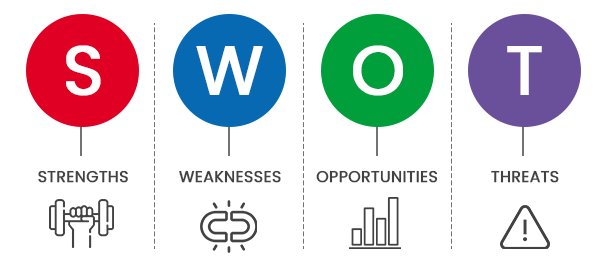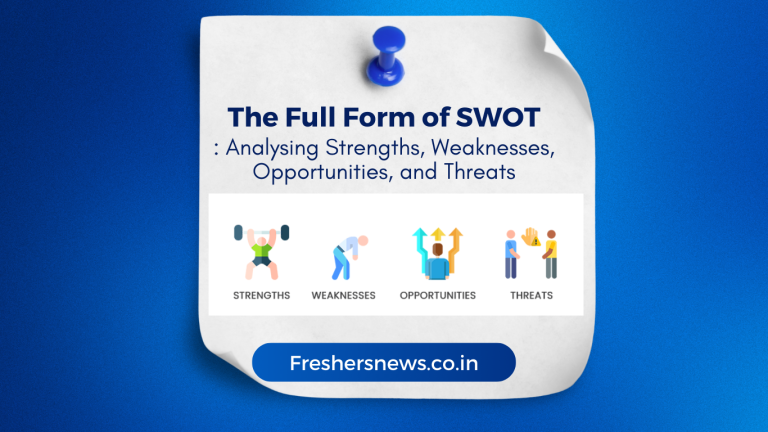Constantly searching for methods to evaluate their position and make strategic decisions, organizations in the fiercely competitive business landscape turn to various tools and frameworks. One such tool, SWOT analysis, is widely used to assess a company’s performance by examining internal and external factors. This article thoroughly explores SWOT analysis by delving into each component, highlighting their significance in strategic planning. Businesses may successfully use this powerful tool to design their plans based on useful findings by acquiring a solid grasp of SWOT analysis. Here we are talking about The Full Form of SWOT: Analysing Strengths, Weaknesses, Opportunities, and Threats.

We are discussing The Full Form of SWOT: Analysing Strengths, Weaknesses, Opportunities, and Threats:
Introduction
In the current business landscape, it is imperative for companies to have a deep grasp of their internal capacities and the ever-changing market forces at play. This awareness empowers leaders to plot a path that leverages their strengths, minimizes weaknesses, seizes opportunities, and successfully maneuvers around threats.
One valuable tool for achieving this comprehensive understanding is the strategic planning technique known as SWOT analysis. By undertaking a thorough SWOT analysis, organizations gain a complete view that guides them in making informed choices, crafting strong strategies, and maintaining a competitive edge.
Strengths
Strengths include a strong brand, a devoted client base, a solid balance sheet, innovative technology, etc., which indicate what a firm excels at and what sets it apart from competitors. For instance, a hedge fund could have created a proprietary trading method that outperforms the market. The next step is determining how to exploit the results to attract additional investors.
Weaknesses
An organization’s weaknesses prevent it from operating at its highest potential. A bad brand, higher-than-average turnover, high levels of debt, an insufficient supply chain, or a lack of cash are areas where the company must improve to stay competitive.
Opportunities
Opportunities are advantageous outside variables that could give a company a competitive edge. If a nation lowers its tariffs, a car manufacturer may export its vehicles into a new market, boosting sales and market share.
Threats
Threats are things that could do something bad to an organization. For instance, a corporation that produces wheat is at risk from a drought since it might ruin or diminish crop production. Other frequent dangers include escalating material costs, fiercer competition, a shortage of workers, and so forth.
How to Conduct a SWOT evaluation
This entire post is devoted to answering that question, but for the sake of simplicity, here is how to conduct a SWOT analysis:
- Gather your team together, and if possible, bring goodies.
- Prepare your quadrants on a whiteboard or projector (using our template, if necessary).
- Start with strengths and ask the questions listed below.
- The same holds for vulnerabilities, opportunities, and hazards.
- Organize the gathered information into an orderly document.
- Distribute team-specific notes.
- Plan a second meeting to identify action items and their proprietors.
Advantages of a SWOT Analysis
A SWOT analysis cannot answer all of a company’s significant questions. However, a SWOT analysis has several advantages that facilitate strategic decision-making.
The SWOT analysis simplifies the resolution of complex problems. When making a complex decision, there may be overwhelming data to analyze and pertinent factors to consider. A SWOT analysis prepared by reducing all ideas and ranking elements by importance will aggregate a large, potentially overwhelming problem into a report that is easier to comprehend.
A SWOT analysis necessitates consideration of external factors. A company may be compelled to consider only internal factors when making decisions far too often. However, external factors frequently can affect the outcome of a business decision. A SWOT analysis considers the internal and external factors a company can manage.
A SWOT analysis applies to nearly all business questions. It may pertain to a company, a group, or an individual. In addition, it can analyze an entire product line, brand changes, geographical expansion, or an acquisition. The SWOT analysis is a flexible instrument with numerous applications.
A SWOT analysis utilizes various data sources. A business will likely use internal data to determine its assets and weaknesses. Additionally, the company must collect external information regarding broad markets, competitors, and macroeconomic forces to identify opportunities and threats. A good SWOT analysis compiles multiple perspectives rather than relying on a single, possibly biased source.
Preparing a SWOT analysis may not be prohibitively expensive. Some SWOT reports do not need to be excessively technical; therefore, many staff members can contribute to their creation without specialized training or outside consultation.
SWOT analysis is a flexible technique that may be used in a variety of business situations, including new product launches, market expansions, mergers and acquisitions, and strategic planning exercises. It also provides a formal framework for evaluating an organization’s internal capabilities.
Now let us also look at how SWOT analysis helps to evaluate the daily life and works of individuals:
| Aspect of Life | Strengths | Weaknesses | Opportunities | Threats |
| Career | Relevant skills and experience | Procrastination | Job promotions or career changes | Economic downturn or job insecurity |
| Education | Strong study habits | Difficulty in certain subjects | Scholarships or educational programs | Limited access to resources or opportunities |
| Relationships | Good communication skills | Trust issues | Networking events or social groups | Conflict or misunderstanding |
| Health and Fitness | Discipline and motivation | Sedentary lifestyle | New fitness trends or programs | Health issues or injuries |
| Personal Finance | Good budgeting and saving habits | Impulsive spending | Investment opportunities | Financial emergencies or debt |
| Personal Development | Self-awareness and self-reflection | Fear of failure | Personal growth workshops or courses | Negative influences or distractions |
FAQs about SWOT Analysis
What are the main benefits of conducting a SWOT analysis?
A SWOT analysis helps organizations identify key internal and external factors affecting their performance, prioritize strategic initiatives, make informed decisions, anticipate risks and opportunities, align resources effectively, and improve overall competitiveness.
How often should a SWOT analysis be conducted?
SWOT analysis should be conducted periodically, typically as part of strategic planning or when significant changes occur in the business environment. It is recommended that the analysis be reviewed and updated regularly to ensure its relevance and accuracy.
Can SWOT analysis be used for personal development?
SWOT analysis can be applied to personal development to assess individual strengths, weaknesses, opportunities, and threats. It can help individuals identify areas for improvement, leverage strengths, pursue career opportunities, and overcome challenges.
Are there any limitations to SWOT analysis?
While SWOT analysis provides valuable insights, it has limitations, including subjectivity, reliance on qualitative data, oversimplification of complex issues, lack of prioritization, and potential bias in identifying factors. It is important to supplement SWOT analysis with other strategic planning tools and methodologies for a comprehensive analysis.
Conclusion
SWOT analysis provides valuable insights into an organization’s strengths, weaknesses, opportunities, and threats. By thoroughly analyzing these factors, businesses can leverage their strengths, address weaknesses, seize opportunities, and manage threats. It acts as a framework for strategic planning, allowing organizations to make informed choices and achieve long-term growth amidst a constantly changing business landscape.



